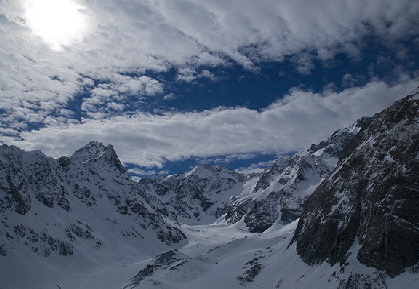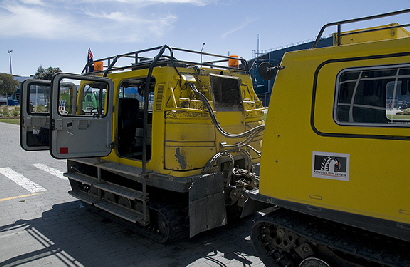|
Mount Cook on the South Island
By Larry and Lilliam Larsen
The terrain from Christchurch southeast through the Mackenzie Basin to Lake Tekapo and Mount Cook is some of
the prettiest, rolling countryside anywhere on earth. In the spring, the hills and mountains are covered with multi-hued vegetation
 of greens and yellow, and rocks varying from red to black. The beautiful backdrop of mountain
peaks covered with snow is always impressive, particularly when associated with lakes and meandering streams. To say that the scenery approaching Mount Cook is spectacular is to put it mildly. of greens and yellow, and rocks varying from red to black. The beautiful backdrop of mountain
peaks covered with snow is always impressive, particularly when associated with lakes and meandering streams. To say that the scenery approaching Mount Cook is spectacular is to put it mildly.
The hills give way to some wide open flatland mixed with yet taller
hills, while the Southern Alps are seen in the distance. Lake Tekapo, a highlight of the island, is the largest highest lake in New
Zealand. It has an amazing turquoise blue color which is created by "rock flour", a fine dust from rocks which were ground by
glaciers near their headwaters. These suspended particles in combination with the sunlight create Lake Tekapo's unique water color.
The South Island's main feature of course, is stunning Mount Cook, renowned for its historical significance in world
mountain climbing. At 12,316 feet, New Zealand's highest mountain, called "Aoraki Mount Cook" is dazzling, yet there are 27
 other mountains in this alpine backbone which peak at over 10,000 feet, and hundreds of others not
far short of that – all making up the famous Southern Alps. Aoraki means "cloud-piercer" in the native Maori language, and seeing Mount Cook without clouds covering
its peak is somewhat unusual. But we had a clear view of the peak on our second day there. other mountains in this alpine backbone which peak at over 10,000 feet, and hundreds of others not
far short of that – all making up the famous Southern Alps. Aoraki means "cloud-piercer" in the native Maori language, and seeing Mount Cook without clouds covering
its peak is somewhat unusual. But we had a clear view of the peak on our second day there.
We stayed at the Hermitage Hotel, which lies at the foot
of the Mount Cook and near the Sir Edmund Hillary museum. It offers excellent accommodations and is perfectly placed for visitors to explore the area by any of
the nearby means such as ATVs, rafts, helicopter, skiplane, 4-wheel drive vehicles, hiking or cross-country skiing in season. We did several of the activities, however, our
Squirrel Helicopter ride past Mount Cook through spectacular scenery and landing on the Tasman Glacier the highlight of our trip to the Sound Island.

 We flew over Tasman's Terminal Lake at the base of the glacier and viewed the huge floating icebergs. Yep, we did
the helicopter ridge hopping that gives pause and then exhilaration when clearing the rocky outcropping and quickly dropping down on the other side of the ridges. It was just
like the IMAX movie experience of flying in the mountains only reality! The helicopter landed on the glacier and we were able to walk on ice fields that no other human had stepped on before. We flew over Tasman's Terminal Lake at the base of the glacier and viewed the huge floating icebergs. Yep, we did
the helicopter ridge hopping that gives pause and then exhilaration when clearing the rocky outcropping and quickly dropping down on the other side of the ridges. It was just
like the IMAX movie experience of flying in the mountains only reality! The helicopter landed on the glacier and we were able to walk on ice fields that no other human had stepped on before.
Later that day, we took a four-wheel drive to the other side of the ridge that borders the ice field and climbed
several hundred feet to its height – the wind and the narrow ridge was a bit scary, but sitting down and taking time
to view the uninterrupted view for miles around us was worth it. You must be
 in fairly good physical shape to really enjoy all that this area has to offer outdoors. We need to come back while we are still young enough! in fairly good physical shape to really enjoy all that this area has to offer outdoors. We need to come back while we are still young enough!
When heading for the North Island, we made a quick stop
in Christchurch. There, we visited a very interesting attraction – the International Antarctic Center – which is highly recommended. In addition to magnificent 3D and 4D
movies, you can ride a Hagglund (an all-terrain amphibious Antarctic vehicle), see Little Blue Penguins rehabilitation center, and explore many interesting hands-on exhibits
regarding the scientific exploration of the Antarctic region. The first class attraction is located directly across the street from the United States Antarctic headquarters near the airport.
Editor's Note: For more information on Mount Cook and New
Zealand's South Island, contact www.southisland.org.nz, www.Mountcooknz.com and www.christchurchnz.net. Info on Hermitage is at
www.hermitage.co.nz, the Mount Cook Ski Planes (Squirrel Helicopter rides) can be found at www.new-zealand.com/SkiPlanes, and on the International Antarctic Centre is at www.Iceberg.co.nz.
|